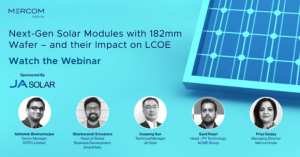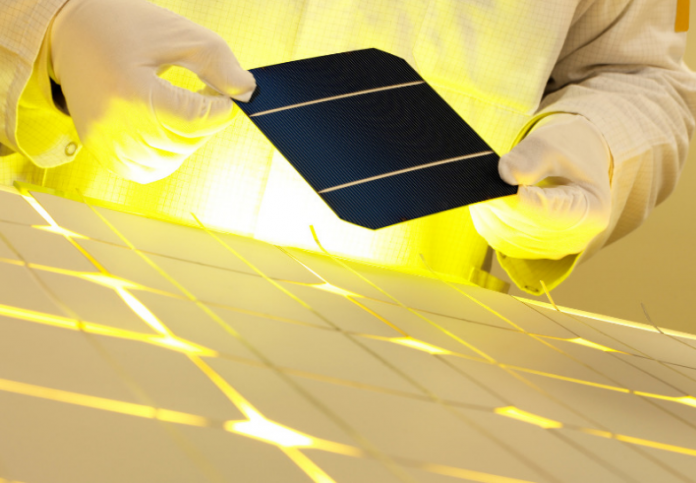Mercom hosted a webinar on September 8, 2021, to discuss the impact of the rapidly changing module manufacturing landscape on the project’s levelized cost of energy (LCOE). The webinar focused on the ever-evolving solar module technologies and their impact on the solar module manufacturers aiming to achieve higher efficiencies at the module, cell, and even wafer levels.
The panelists included Abhishek Bhattacharjee, Senior Manager, NTPC Limited; Shankaransh Srivastava, Head of Global Business Development, SmartHelio; Xuepeng Sun, Technical Manager, JA Solar; Syed Naqvi, Head-PV Technology, ACME Solar.
Priya Sanjay, Managing Director, Mercom India, hosted the session.
 The new technological developments include new modules and models with M10 (182 mm x 182 mm) solar cells combining PERCIUM+ technologies, which achieve a conversion efficiency as high as 21%. Compared to the 400 W series modules, the 545 W modules reduce the LCOE of a project by 7-9%, as claimed by JA Solar.
The new technological developments include new modules and models with M10 (182 mm x 182 mm) solar cells combining PERCIUM+ technologies, which achieve a conversion efficiency as high as 21%. Compared to the 400 W series modules, the 545 W modules reduce the LCOE of a project by 7-9%, as claimed by JA Solar.
Technological upgrades in module manufacturing will be a game-changer
As solar photovoltaic technology has evolved over the years, panel efficiency, energy output, and especially costs have plummeted, and there is a constant effort to bring the prices further down.
Speaking on the latest developments in module manufacturing and its impact on the development of projects, Abhishek Bhattacharjee said, “We have not used 500 kWp modules in any of the installations. We are excited about the new developments in the module manufacturing segment, and I believe that it will be a game-changer and help reduce the LCOE of projects. The most important thing for us is that we should not lose money, and there should be a quality check process in place.”
“We intend to procure 1.5 GW-2GW of modules per year to push our projects. The Indian solar market is expanding, and the manufacturing segment is also evolving. Many new players have entered the manufacturing space, and things will only improve with the government’s push. In due course, foreign players will also be enlisted in the approved list of models and manufacturers (ALMM), and by the end of next year, we will also procure modules from them,” added Bhattacharjee.
Sharing his views on the development in module manufacturing technology, Xuepeng Sun stated that the efficiency of solar modules had increased significantly in the last ten years, from 17% to 21%.
“Our latest offering (545 Wp solar modules), which was launched in May last year, has already been used in Rajasthan and Gujarat, and I think its demand will increase with time. The increase in efficiency will help in reducing the LCOE. India is a big market for us, and it’s a very quality-conscious market. We have a stringent quality control process in place, and it’s only a matter of time before developers start using this latest technology,” added Sun.
Early days to pass a verdict
Commenting on the feasibility of the new technologies in the current scenario, Syed Naqvi said, “For us, optimization of tariffs, cost viability, and LCOE are the important factors while selecting modules for the projects. The most important factor is whether the higher output modules are financially
viable as it shows higher degradation, which the developers should consider. The other aspect of this is the presence of destructive hotspots, which need to be replaced. Higher temperature also leads to the cracking of modules and needs to be looked into as well. It’s still very early days, and we need to wait for the practical viability of these modules. The manufacturers’ claims are many, and they need to pass on the benefits to the developers. It becomes all the more important because we are working on very tight financial margins in India.”
“We have 3-6 GW of projects in the pipeline, and we are planning backward integration and in-house manufacturing to cater to our demands. The initiatives by the government are also helping us in meeting this objective. We are looking for technologies that will stay for some time and not become obsolete in two to three years. We are focusing on mono ‘passivate emitter rear cell’ (PERC) technology, which can be easily upgraded to ‘tunnel oxide passivated contact’ (TOPCON). China has two competing camps – one is led by all the major manufacturers promoting 182 mm wafers (M10), whereas others are vouching for 210 mm wafers (M12). I believe that M10 will continue for the next two to three years; however, M12 is still in unchartered territory,” pointed out Naqvi.
Guarantee claims should be addressed efficiently
Developers and power producers will switch to newer technology only if it offers significant cost advantages. Eventually, it all boils down to the LCOE, which determines the future course of action by the developers.
Improved shading behavior and reduction in hotspot temperatures are best-suited for commercial and industrial (C&I) and utility-scale solar projects.
“It takes nearly five to seven years for problems to pop up in a module, which is often ignored initially. We have analyzed data for projects for eight years and concluded that the module degradation was more than 2.5% from what the original equipment manufacturer (OEM) had promised. This affects the voltage output, which in turn affects the module performance. In India, for nearly 40-45% of projects, the module degradation is higher than the OEM claims. These are some factors that developers should consider while procuring modules for projects. There is also a chance of module mismatch if the modules are not from the same batch or of the same watt capacity resulting in losses for the developers. The developers’ warranty claims should be addressed efficiently and be made a seamless process,” opined Shankaransh Srivastava.
“Artificial intelligence (AI) helps the developers detect problems in modules that would appear in the future like micro-cracks that would lead to the degradation of modules. AI will help developers be well-prepared and make decisions wisely,” added Srivastava.
While the panelists agreed that technology upgradation was important, they also felt that the transition should not happen hastily and proper consideration should be given to all the aspects before taking the leap.






